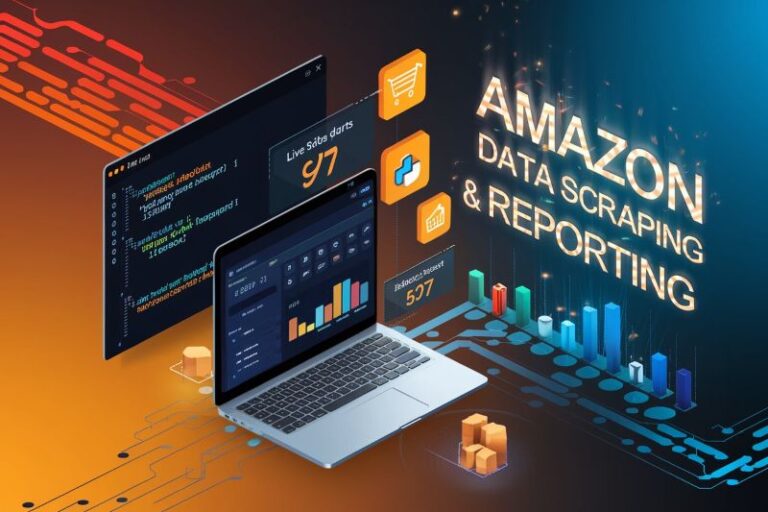Introduction: Why Data Is Your Amazon Business’s Secret Weapon
Imagine this: Your top competitor just slashed prices by 20%, and their reviews surged by 300 in a week. Without real-time data, you’d never catch these shifts until it’s too late. In this guide, you’ll learn how to collect, analyze, and act on Amazon data—whether you’re a coding pro or prefer a no-code approach.
Part 1: For Coders – Building an Amazon Scraper with Python
Step 1: Setting Up Your Toolkit
To scrape Amazon’s Kitchen Appliances Top 100, you’ll need:
- Python 3.8+ (Anaconda recommended)
- Libraries:
requests(HTTP requests),BeautifulSoup/lxml(HTML parsing),selenium(dynamic content),pandas(data processing) - Proxy Services (e.g., BrightData or Oxylabs to avoid IP bans)
Sample Code: Basic Product Scraper
“`python
import requests
from bs4 import BeautifulSoup
import pandas as pd
Mimic a real browser
headers = {
‘User-Agent’: ‘Mozilla/5.0 (Windows NT 10.0; Win64; x64) AppleWebKit/537.36 (KHTML, like Gecko) Chrome/114.0.0.0 Safari/537.36’
}
def scrape_amazon_product(url):
try:
response = requests.get(url, headers=headers, timeout=10)
soup = BeautifulSoup(response.text, ‘lxml’)
# Extract critical data points
title = soup.find('span', id='productTitle').text.strip()
price = soup.find('span', class_='a-price-whole').text
rating = soup.find('span', class_='a-icon-alt').text.split()[0]
return [title, price, rating]
except Exception as e:
print(f"Error scraping {url}: {str(e)}")
return None Example URLs
product_urls = [
‘https://www.amazon.com/dp/B08ZJQVS9Y’, # Air fryer example
‘https://www.amazon.com/dp/B09G9FPHY6’ # Blender example
]
Store results
product_data = []
for url in product_urls:
data = scrape_amazon_product(url)
if data:
product_data.append(data)
Create DataFrame
df = pd.DataFrame(product_data, columns=[‘Title’, ‘Price’, ‘Rating’])
**Common Pitfalls**:
1. **Anti-Scraping Measures**: Amazon blocks aggressive scrapers. Fix: Add 2-3 second delays between requests + rotate proxies.
2. **Dynamic Content**: Use Selenium for JavaScript-rendered data (e.g., product variants): python
from selenium import webdriver
from selenium.webdriver.common.by import By
from selenium.webdriver.support.ui import WebDriverWait
from selenium.webdriver.support import expected_conditions as EC
driver = webdriver.Chrome()
driver.get(‘https://www.amazon.com/dp/B08ZJQVS9Y’)
WebDriverWait(driver, 10).until(
EC.presence_of_element_located((By.ID, “productTitle”))
)
Extract data here
driver.quit()
---
### **Part 2: Data Cleaning & Analysis**
#### **Cleaning Raw Data**
Your raw data will look messy:
- Prices as `$49.99` → Convert to `float`
- Ratings as `4.5 out of 5 stars` → Extract `4.5`
- Titles with extra spaces/symbols → Normalize text
**Pandas Cleaning Demo**: python
Convert price to float
df[‘Price’] = df[‘Price’].str.replace(‘$’, ”).astype(float)
Extract numerical rating
df[‘Rating’] = df[‘Rating’].str.extract(r'(\d+.\d+)’).astype(float)
Clean titles
df[‘Title’] = df[‘Title’].str.replace(‘\n’, ‘ ‘).str.strip()
Save cleaned data
df.to_csv(‘cleaned_amazon_data.csv’, index=False)
#### **Advanced Analysis**
1. **Price Distribution Analysis**: python
import matplotlib.pyplot as plt
plt.figure(figsize=(10, 6))
plt.hist(df[‘Price’], bins=15, edgecolor=’black’)
plt.title(‘Price Distribution of Kitchen Appliances’)
plt.xlabel(‘Price ($)’)
plt.ylabel(‘Number of Products’)
plt.savefig(‘price_distribution.png’)
2. **Competitor Benchmarking**: python
Compare your product vs. competitors
your_product = {‘Title’: ‘Your Air Fryer’, ‘Price’: 54.99, ‘Rating’: 4.8}
competitors = df[df[‘Price’].between(40, 70)]
competitors.loc[len(competitors)] = your_product # Add your product
competitors.to_excel(‘competitor_analysis.xlsx’, index=False)
“`
Part 3: No-Code Solution – Amazon Data Pilot
Why Choose a No-Code Tool?
- Time Savings: Scrape 200 products in 2 minutes vs. 3 hours manually.
- Zero Maintenance: Automatic updates when Amazon changes page layouts.
- Real-Time Alerts: Get Slack/email notifications for price drops or review spikes.
Case Study: Monitoring Home & Kitchen Trends
Scenario:
Lisa sells coffee makers and needs to:
- Track Top 100 products in real time.
- Analyze weight/size trends.
- Generate a competitor pricing report.
Steps with Amazon Data Pilot:
1. Set Up a Scraper in 5 Minutes:
- Install the Chrome extension.
- Navigate to Amazon’s “Home & Kitchen” Best Sellers.
- Click the Data Pilot icon → Select:
- Data Fields: Title, Price, Rating, ASIN, Dimensions, Weight
- Filters: Price range ($20–$150), Rating ≥ 4.0
- Schedule: Daily auto-refresh at 8 AM local time.
2. Clean & Organize Data:
- Use drag-and-drop to reorder columns (e.g., move “Weight” next to “Price”).
- Click “Smart Filters” to exclude refurbished products.
- Rename columns for clarity (e.g., “Item Weight” → “Product Weight (lbs)”).
3. Generate Reports:
- Choose template: “Competitor Price Monitoring Dashboard”.
- Customize:
- Add a histogram showing price distribution.
- Highlight products with >100 reviews in green.
- Export:
- Excel file with pivot tables.
- PDF summary for team meetings.
Feature Spotlight:
- ASIN Linking: Automatically pull product images and descriptions.
- Historical Data: Track price changes over 30/60/90 days.
- Custom Alerts: Flag products with sudden rating drops.
Part 4: Turning Data into Action
1. Dynamic Pricing Strategies
- Rule-Based Adjustments:
- If a competitor’s price < your price by 10% → Trigger email alert.
- If your product’s rating drops below 4.3 → Pause ads temporarily.
2. Inventory Optimization
- Calculate sales velocity:
Units Sold per Day = Total Sales / 30 - Set reorder points:
Reorder When Stock ≤ (Lead Time × Daily Sales) + Safety Stock
3. Review Analysis
- Use NLP tools (e.g., MonkeyLearn) to:
- Detect negative sentiment in reviews.
- Extract frequent complaints (e.g., “leaking”, “broken lid”).
Conclusion: Start Small, Scale Smart
Whether you code or not, begin with these steps:
- For Coders:
- Scrape 10 products daily → Build a pricing history database.
- Automate email alerts using Python’s
smtplib.
- For No-Code Users:
- Set up 1–2 critical dashboards (e.g., BSR tracking).
- Schedule weekly competitor reports.
Pro Tip: Combine both approaches! Use Amazon Data Pilot for daily monitoring and Python for custom analytics.
Ready to Start?
- Coders: Clone this GitHub Scraper Template.
- No-Code Users: Claim Your 200 Free Credits.

